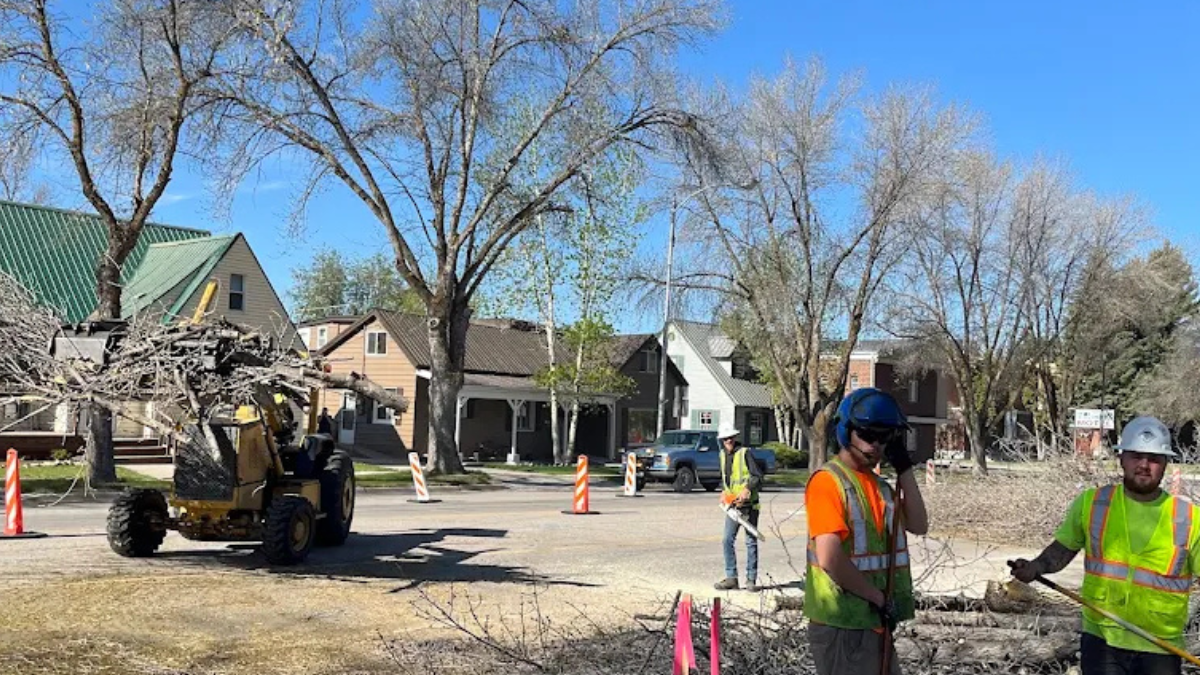You can cut down a tree yourself only if it’s small, healthy, and in an open area with no nearby hazards. Many homeowners in South Salt wonder if they can save money by removing trees on their own. This matters because DIY tree removal risks include serious injuries, property damage, and legal problems.
Tree cutting looks simple from the ground. But the truth is different. Chainsaw accidents DIY happen fast, and falling branches dangers can hurt you or damage your home.
Learning the right way to cut trees keeps you safe. This guide shows you when DIY works and when you need help. You’ll discover tree cutting safety tips, local tree removal permits, and why professionals matter.

When DIY Tree Cutting Is Possible in Salt Lake City
Small, healthy trees under 15 feet tall are safe to cut yourself in open areas. The tree must be straight with no lean. The area must be completely clear of obstacles.
Small, Healthy Trees
Small trees are easier to handle. They fall predictably. You need less equipment and space. Trees under 15 feet with no disease work best for DIY removal.
Open Areas
The area must be free of obstructions. No buildings nearby. No vehicles parked close. No utility lines overhead. Clear space means the tree can fall safely without hitting anything important.
When to Hire a Professional Tree Service
Large trees, leaning trees, and trees near structures need professional removal. This is where professional tree removal benefits matter most.
Large Trees
Large trees are dangerous and should be handled by professionals. Trees over 20 feet need special equipment. They weigh thousands of pounds. One mistake causes major damage or injury.
Leaning or Diseased Trees
Leaning or diseased trees have unpredictable falls and pose serious risks. You can’t predict which way they’ll fall. Rot weakens the trunk. Tree structural weaknesses make the job unpredictable and unsafe.
Near Structures or Utilities
Trees near structures or power lines should only be removed by an arborist. Electrocution hazard tree removal is real. Branches can hit your roof. Roots can damage your foundation. Professionals have insurance and training.
Lack of Experience or Confidence
Lack of expertise tree removal causes accidents. If you’ve never done this before, hire someone. Your safety matters more than saving money.
Essential Safety Precautions if You Cut Down a Tree Yourself
Safety Gear
Wear steel-toed boots, gloves, goggles, and a hard hat. Use chainsaw chaps to protect your legs. Long pants are required. Never skip safety equipment.
Partner
Always work with a spotter. Your partner watches for danger. They call for help if something goes wrong. Never cut alone.
Clear the Area
Remove vehicles, furniture, and toys. Mark off the work zone. Keep people and pets away. Tree removal planning includes clearing everything.
Plan Escape Routes
Plan two escape routes before you start. Run opposite the fall direction. Practice your escape path first. Know where you’ll go.
Check Local Regulations
Tree removal legal permits are required in South Salt. Call the city first. Some trees are protected. Breaking rules costs money and causes legal trouble.
Salt Lake City Rules & Permits for Tree Cutting
Park-Strip/Right-of-Way “City Trees” (Permit Required)
City trees need permits. These are trees on public land. You can’t remove them without permission. Fines are expensive.
Trees Fully on Private Property (Typical Rules)
Your own trees usually don’t need permits. But check first. Some trees are protected species. Local ordinances may apply.
Who Issues Permits and How to Apply
Contact Salt Lake City’s Urban Forestry Division. They issue tree cutting permits. The process takes time. Apply early.
Permit Fees, Mitigation, and Penalties
Permits cost money. Fines for illegal removal are higher. Tree removal regulatory compliance saves you trouble and money.
Safety & Utility Checks Before Cutting a Tree
Overhead Power Lines and 10-Foot Clearance
Keep trees 10 feet away from power lines. Electrocution hazard tree removal kills people. Call your utility company first.
Call 811 (Blue Stakes of Utah) Before Digging/Grinding
Underground lines exist. Call 811 before you dig. They mark utility lines for free. This prevents accidents.
Assessing Lean, Rot, and Structural Defects
Check if the tree leans. Look for soft spots. Tree structural weaknesses make cutting dangerous. When in doubt, hire professionals.
Slope, Fences, and Building Clearances
Sloped ground changes how trees fall. Fences and buildings limit your space. Measure twice. Plan carefully.
When You Shouldn’t Attempt DIY Tree Cutting
Near Power Lines or Service Drops
Never cut near power lines. Professional arborist consultation is required. Professionals have training and insurance.
Dead/Hollow, Storm-Damaged, or Large Hazard Trees
Dead trees are unpredictable. Storm damage weakens trees. Hazardous tree removal skills require experience. Hire professionals for these jobs.
Jobs Requiring Rigging, Bucket Truck, or Crane
Complex removals need special equipment. Tree rigging for safe removal requires certification. Professionals have the right tools and training.
Conclusion
DIY tree removal works only for small, healthy trees in completely open areas. Most homeowners should hire professionals. The risks are too high. Tree removal cost vs risk usually favors hiring experts.
Professional tree removal benefits include safety, insurance, and proper disposal. Professionals have training, equipment, and tree removal liability insurance. They know local tree removal permits and regulations. They work fast and clean.
We are the trusted tree removal company in South Salt. Diamond Tree Experts handles every job safely. We protect your property and your family. Contact us today for a free estimate. We’ll help you decide the best option for your trees.

